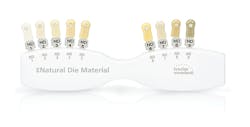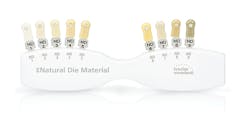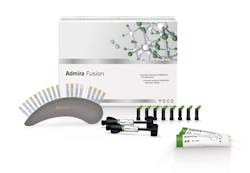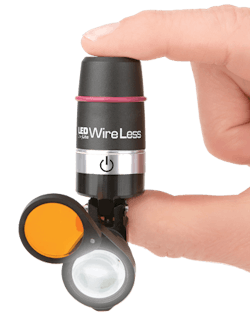Pearls for Your Practice: Stump shade guide, ceramic-based direct restorative material, wireless LED headlight
Joshua Austin, DDS, FAGD, reviews a stump shade guide, a ceramic-based direct restorative material, and a wireless LED headlight.
Natural Die Material Shade Guide by Ivoclar Vivadent Inc.
This week, I am hanging out at the Seattle Study Club Symposium. It's an honor to be in the same room as some of the most talented clinicians in the world. During these lectures, I have seen some incredible work done with indirect ceramics. The artistry I've seen has made my jaw drop. I always wonder how ceramists can create such natural beauty in situations where there are differences in the substrates. How can we best communicate to our laboratories about the shade of our preparations? By far, the best way is with the Natural Die Material Shade Guide from Ivoclar Vivadent Inc.
By giving your ceramist a stump shade, you provide an incredible advantage for fabricating the most esthetic restoration possible. The Ivoclar Natural Die Material Shade Guide includes nine different shades. Your lab technician can use this information to make a model die that is the same shade as the preparation and make sure there is no show-through or shade change to the ceramic from the underlying tooth structure.
Do you need to use this for a single-unit crown on a second molar? No, that's probably pretty useless, as the ceramic back there is probably much thicker and will block out any darkness from below. On the other hand, I'm sure that we all have struggled in the past with handling a darkened, endo-treated anterior tooth. A stump shade will give your technician a fighting chance.
This shade guide, which can be ordered from any major dental supplier, needs to be a part of any anterior ceramic case you do. The die materials that technicians use for esthetic cases don't come in our traditional Vita shades. Believe me, your technician will be delighted to have an actual stump shade. It will make his or her job easier, which makes your job easier. Hard single up the middle for Ivoclar!
Voco's Admira Fusion
In the past, we were able to classify dental materials in neat little cubbyholes that we all knew well. Over the past couple of years, one big trend has been a blurring of these lines. We are seeing materials that straddle the traditional lines, forcing us to rethink the classifications we've used for so long, and Admira Fusion is one of those materials.
Admira Fusion is a direct restorative material, indicated for use in all of the same ways as composite. Voco calls Admira Fusion a "nano-ORMOCER." That is a combination of letters I had never seen before reading about Admira Fusion, so let's see if we can sort this out together. Voco combined a couple of different technologies to end up with "nano-ORMOCER." The first of these should be pretty familiar to us: nano-hybrid technology. Most of the high-end composites used today are nano-hybrids. The "ORMOCER" part is what distinguishes Admira Fusion from other materials: "ORMOCER" stands for "organically modified ceramic." So what does that mean? Well, it means that Voco has created a direct restorative material with properties of both composites and ceramics.
The most important property of Admira Fusion is a significant reduction in polymerization shrinkage. Shrinkage is a problem that leads to marginal leakage, recurrent decay, tooth fracture, etc. We've seen low-shrinkage materials before, but they never caught on because they required a special adhesive, called silorane, to make them work. Admira Fusion can be used with any traditional bonding system-be it total-etch, self-etch, or universal. With a shrinkage stress lower than any composite on the market, Admira Fusion is absolutely worth looking into.
The great thing about Admira Fusion is that it's compatible with our existing direct restorative procedures, so you can use the same etching and bonding steps to which you are accustomed. Admira Fusion handles and feels like traditional composite, and you won't need any special instruments or dispensers to place it. It can be seamlessly integrated into your process.
Admira Fusion handles well and is easy to push and shape. It's available in a total of 18 different shades in three different opacities. That means it's not just a posterior direct restorative; it can be used in the anterior, too. Due to its nano-hybrid technology, it polishes well and will retain that polish over time. As you might expect, Admira Fusion is also radiopaque, so you don't need to worry about not seeing it on a radiograph.
I think it is very important that we see further development in our direct restorative materials. The past decade has been the era of ceramics, as lithium disilicate and full-contour zirconia have taken over the indirect market. A couple of years ago, we saw the introduction of indirect materials that combined resin and ceramic. It's my hope that Admira Fusion will usher in an era of direct restorative materials with the strength of ceramic and the direct application offered by composite. Admira Fusion is a milestone in the evolution of restorative dental materials-an improvement in physical properties with no compromises in terms of increased steps or time. That's a huge win. Hard, line-drive triple for Voco with Admira Fusion!
DayLite WireLess LED headlight from Designs for Vision Inc.
There are a few items around my office that I could not practice without. My loupes are one of those things. It goes a bit deeper than that, though, because the problem with magnification is that light in the field decreases as magnification increases. At 3x, it starts to get pretty dark, so some additional illumination is required. I have tried many different headlamp options, all of which were corded. Some were expensive, name-brand lights, and others were cheap, generic lights. Regardless of cost, most of them caused me some headaches: The bulb would go out, the cord would short, or sometimes, the battery pack would go on the fritz. Then, there were the dreaded cord-snagging incidents-my favorite of which was when the cord from my light would get caught on the air-water tip and jerk my loupes off when I stood up. All of this was annoying enough, but when I developed neck issues from the constant tension of a cord on one side of my head, I realized I would need to find a better solution.
Designs for Vision Inc. has created the perfect headlamp, which has ended all of my frustrations. The DayLite WireLess has a high-intensity mode and a medium-intensity mode. I find the high-intensity mode is bright enough for any magnification level I use. The medium-intensity mode is a little dim for 5x magnification but bright enough for 3x magnification.
The DayLite WireLess headlamp mounts to any major brand of loupes. Being completely self-contained, it has no cords and no hip-hanging battery pack. It's lightweight, as well, unlike older cordless systems that had heavy battery packs on the arms of the loupes, which threw off the weight balance and induced ergonomic issues. There are no weight issues with the DayLite WireLess; in fact, the weight is almost negligible.
So, how does Designs for Vision craft this magic? The light is powered by a small battery pack, which measures approximately one inch in length and is roughly as wide as a quarter. It screws in and sticks up like a beautiful, magical unicorn horn between your eyes. It is powered on and off with the touch of a silver band. The battery lasts for approximately four hours. I find myself putting on a new battery pack first thing in the morning. That battery gets me through the morning. At lunch, I put a new battery on, and that carries me through the afternoon. Included with the DayLite WireLess are a battery-charging station, three batteries, an orange composite filter ring, and three color rings to differentiate all three batteries.
After approximately eight weeks of use, I have difficulty finding downsides to using this headlamp. If I had one criticism, it would be about the capacitive touch that turns the light off and on. Sometimes I accidentally touch it when adjusting my loupes, and the light turns off or on when I don't want it to. But that is me searching for criticism-this light is awesome! Having one cord fewer to deal with makes my life easier. The extra batteries make getting through the day viable, and ergonomically, it has improved my head and neck position. I have absolutely loved using this light and hope to use it for many years to come. Grand-slam home run for Designs for Vision!



